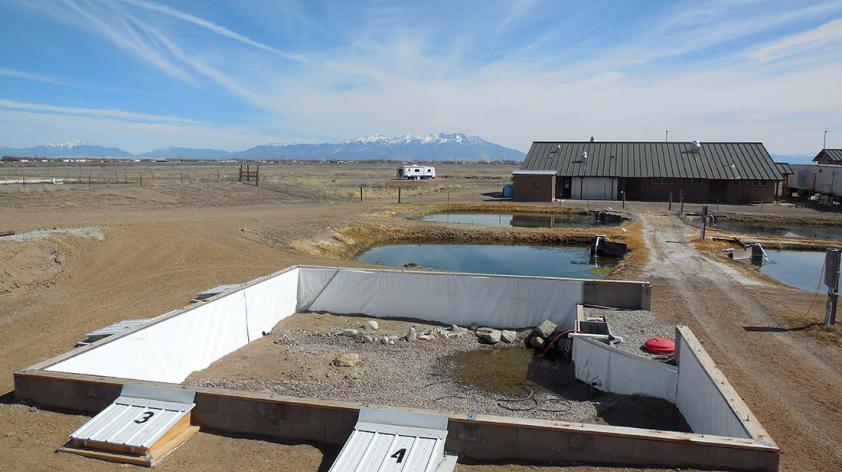
“Toad in a Hole”
Have you ever been stuck in a traffic jam? As you waddle forward you look right and left hoping to find a simple explanation for why you and a hundred other lucky drivers are stuck bumper to bumper. Then the all too familiar vision of road works pops into view and there, standing around a pit are a dozen men in hard hats. One man sits on an excavator while the other points to something in the hole while other men lean heavily on their shovels, pointing and chatting. As you crawl by them you think how many men does it take to discuss a hole? This was my question to guys sitting around a giant hole as I shuffled past on my morning jog around Colorado Parks and Wildlife’s Native Aquatic Species Restoration Facility (NASRF), at the north end of the 749-acre Playa Blanca State Wildlife Area near Alamosa, Colorado. I was at the facility as an extension of my work for the San Diego Zoo Institute of Conservation Research, and knew just who to ask about what was going on. Jim Garcia, Assistant Manager at NASRF is the mastermind behind the project. “Well, it looks like a hole now but soon it will be the all new an improved outdoor toad enclosure” Jim explained.
As the guys measure, discuss, point and level, Jim tells me what he envisions. A sort of oasis, this new outdoor enclosure will have a pond, lots of natural flora and custom-made hibernacula (like cement block igloos for over wintering). The hibernacula will come fitted with an underground hydro-heating system that will prevent toads from freezing over the winter. Boreal toads spend the winter months brumating. It is a more active form of hibernating in which animals lower their metabolism to levels that allow them to conserve energy and fast through the winter. These boreal toads are part of the Southern Rocky Mountain population (SRM), which is unique to Colorado, Wyoming, New Mexico, and Utah. NASRSF houses the largest SRM captive population in the US and has been actively breeding and re-introducing these animals back into the wild as part of an ongoing re-introduction program since 2001.
NASRF Staff from left to right Group Shot from left to right; Back row = Travis Gonzales, Christopher Haley, David Westerman, Tom Mix, Noel Heredia, Brian Nichols, Ted Smith, James Garcia and Mark Haver. Front row from left to right = Joshua Houghtaling, Tim Carden, Daniel Garcia and Natalie Calatayud
Armed with his hard hat, Jim directs his enthusiastic helpers, Brian and Noel. Brian provides muscle and architectural suggestions while Noel jumps on the backhoe, digging, sifting, and flattening the ever-expanding pit. Outdoor amphibian enclosures are not common in captive breeding programs, primarily because it is harder to maintain strict levels of biosecurity than in a lockable building. Biosecurity is the term we use to indicate that a colony is clear of any diseases that may be found in the wild. However, the more we learn about amphibians the more we become aware of the limitations of trying to recreate the outdoors indoors as well as the dangers of captive environments becoming too sterile.
The staff at NASRF has worked hard over the last 15 years to try and tackle some of the all-too-familiar problems encountered in amphibian captive colonies. Common issues arising include unknown nutritional requirements and the simulation of correct seasonal cues to enable these animals to experience their natural life cycles. However, UV lights, recirculating water systems, fake plants, artificially controlled water and atmospheric temperatures, imposed hibernations, and limited diets will never replace nature’s sun, ponds and streams, and endless smorgasbord of prey items. This new outdoor enclosure is a bold move that will hopefully pay off. For now, winter has come to NASRF and the toads have been put to bed in their hibernacula. Come spring, they will emerge into a new outdoor enclosure and the staff at NASRF has big plans to finish the outdoor enclosure and turn it into a toad oasis. Real vegetation, a pond, and access to plenty of natural insects should have profound positive effects on the fitness of these toads.
My role in this project started four years ago, as my specialty is in the reproductive physiology of amphibians, particularly, frogs and toads. Amphibian research has recently opted to use assisted reproductive technologies (ART) to enhance captive breeding in a wide variety of amphibian species, and working with hormones to promote reproduction is one of the goals of my research. In 2014, I joined the Division of Reproductive Physiology at the Institute for Conservation Research and teamed up for yet another summer with my colleagues at NASRF.
In a previous article on the boreal toad, I talked a little about ART side of my job. However, that summer of 2014 marked a slight change in direction when I found myself expanding my horizons and becoming more involved in husbandry-related research that concentrated on optimizing lighting, water quality, and nutrition. Altogether, research on the natural history of animals’ and ART are ways that captive propagation programs are helping a number of endangered species to recover from dwindling populations. Our own mountain yellow-legged frog program at the Institute for Conservation Research is a good example. With less than 200 individuals estimated to be left in the wild in 2015, and a growing captive population of over 200 individuals, the recovery program for this species has been particularly successful in the last year.
So the take home message is, studying the natural history of each species is essential before opting to use ART. What this new project—“toad in the hole”—presents is an opportunity to test the effects of simulated versus natural environments on the health and reproduction of captive boreal toads.













